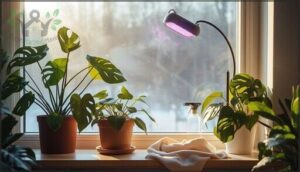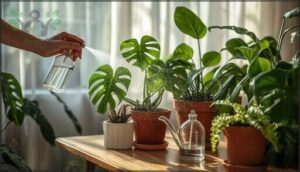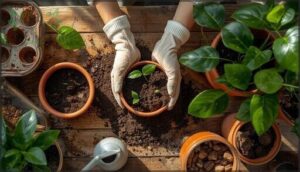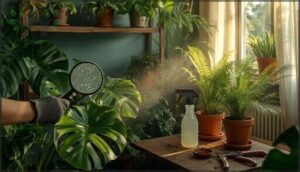This site is supported by our readers. We may earn a commission, at no cost to you, if you purchase through links.
 Sunlight streaming through your windows might look inviting, but it doesn’t always tell the full story for your houseplants. Even a bright living room can leave some greenery struggling, while a shady corner may surprise you with a thriving fern. Matching plants to your home’s unique conditions is trickier than it seems.
Sunlight streaming through your windows might look inviting, but it doesn’t always tell the full story for your houseplants. Even a bright living room can leave some greenery struggling, while a shady corner may surprise you with a thriving fern. Matching plants to your home’s unique conditions is trickier than it seems.
If you’ve ever watched a new leaf wilt or wondered why your kitchen basil turns yellow, you’re not alone. With the right indoor plant care tips, you can transform frustration into lush growth, finding the sweet spot for every plant and every room, no matter the season.
Table Of Contents
- Key Takeaways
- Choosing The Right Indoor Plants
- Optimizing Light and Temperature
- Watering and Humidity Essentials
- Soil, Fertilizing, and Drainage Tips
- Maintenance, Pest Control, and Advanced Care
- Frequently Asked Questions (FAQs)
- How do you care for indoor plants?
- What are the best indoor plant care tips?
- How to keep your indoor garden healthy with little work?
- How do you take care of a houseplant?
- What is indoor plant care?
- How do I Keep my houseplants healthy?
- How can indoor plants improve mental well-being?
- What are creative ways to display houseplants?
- Which plants are best for air purification?
- How do I safely introduce pets to houseplants?
- Conclusion
Key Takeaways
- You’ll need to measure your home’s light conditions with a light meter or foot candles before choosing plants, since even bright rooms can mislead you about what will actually thrive there.
- Match your plants to specific rooms based on their natural needs—living rooms work well for sun-lovers, bathrooms suit humidity-loving ferns and orchids, and kitchens are perfect for herbs or low-light snake plants.
- Beginners should start with forgiving plants like snake plants or ZZ plants that tolerate irregular watering and varied light, building confidence before moving to more demanding species.
- Your lifestyle matters as much as your space—busy travelers need succulents, pet owners should choose spider plants, and families with kids benefit from hands-on, kid-friendly options.
Choosing The Right Indoor Plants
Finding the right indoor plants starts with understanding your own space and routine. Every home offers unique conditions, and your lifestyle plays a big role in what will thrive.
Let’s look at a few key factors that can help you pick the best plants for your needs.
Assessing Light Conditions in Your Home
Before you pick a plant, take a moment to observe the lighting conditions in each room. Use a light meter to gauge brightness at the foliage height. Consider window orientation—south-facing spaces soak up the most sun, while north windows stay dim.
To measure the light levels, you can use foot candles for accuracy. Pay attention to seasonal variation, and supplement with artificial lighting for plants that crave steady, specific light requirements all year.
Selecting Plants for Different Rooms
Once you’ve observed the light in each room, it’s time to match your plant selection to those conditions. Living room plants like broad-leaf foliage enjoy steady sunlight, while bedroom air benefits from plants that release oxygen at night.
Kitchens are ideal for herbs, and bathrooms with higher humidity levels suit ferns or orchids. Even your office can fight stress with the right houseplants.
For darker kitchens, a great choice is the low-maintenance snake plant.
Easy-Care Houseplants for Beginners
If you’re new to indoor plant care, start with beginner plant species like snake plant or ZZ plant—they’re easy to care for, thrive under varied light requirements, and forgive irregular watering schedules.
Beginner-friendly houseplants like snake plant and ZZ plant thrive in various light and forgive irregular watering, making indoor care stress-free
These easy-to-care-for houseplants help you avoid common mistakes and build confidence. Choosing the perfect houseplant means less stress and more long-term care success in your home.
Matching Plant Types to Your Lifestyle
Once you’ve tried easy-care houseplants, it’s smart to match indoor plants to your daily rhythm. For example, travel-friendly plants like succulents suit busy schedules, while pet-safe choices—think spider plants—keep furry friends safe. Kid-friendly plants add hands-on learning at home. If space constraints or time commitment matter, tailor your plant selection and care tips to fit these requirements.
- Travel-friendly plants
- Pet-safe choices
- Kid-friendly plants
- Space constraints
- Time commitment
Optimizing Light and Temperature
Getting the right balance of light and temperature makes all the difference for your indoor plants. Each type of plant has its own needs, and your home’s environment plays a big role.
Here’s what you should know to help your plants thrive year-round.
Understanding Plant Light Requirements
Ever wonder why some houseplants seem to stretch toward the window, while others stay compact and lush? Light intensity, spectral composition, and photoperiod needs all shape how your plants grow. Whether you’re working with natural or artificial light, understanding light classifications and exposure helps you meet specific light requirements for plants.
Here’s a quick comparison:
| Light Type | Intensity (μmol m⁻² s⁻¹) | Best For |
|---|---|---|
| Natural Sunlight | ~2,000 | High-light plants |
| White LED | 100–300 | Most houseplants |
| Fluorescent | <100 | Shade-tolerant |
Best Placement for Sun-Loving Vs. Shade Plants
For growth optimization, matching species placement to your home’s lighting conditions is key. Sun-loving plants thrive with high light intensity near south-facing windows, soaking up direct sunlight for vigorous growth. Shade plants, on the other hand, adapt best to north-facing windows, where light exposure is gentler.
Understanding plant light requirements makes sure each species receives the sunlight it needs.
Adjusting to Seasonal Light Changes
When winter light reduction hits, your houseplants need extra care to stay healthy. You can weave in a few smart strategies:
- Move plants closer to windows for better sunlight.
- Clean glass and leaves to boost natural light.
- Use supplemental lighting benefits like grow lights for steady growth.
- Adjust watering and nutrition—plants need less during darker months.
These steps keep your indoor garden thriving.
Maintaining Ideal Indoor Temperatures
Did you know sudden temperature fluctuations can stress up to 30% of your indoor plants? For ideal plant care, aim for daytime temperatures between 65–80°F, with nighttime cooling about 10°F lower.
Use smart thermostats for seasonal adjustments, especially in species sensitive to cold drafts. Stable temperature and air humidity make your indoor environment a haven for thriving houseplants all year.
Watering and Humidity Essentials
Getting watering and humidity right is the secret to keeping your indoor plants healthy. These essentials can make all the difference, no matter what type of plant you have. Here’s what you need to know to set your plants up for success.
How to Water Indoor Plants Properly
Did you know most houseplants lose out because of poor watering habits? You’ll want to focus on water quality, soil moisture, and smart application methods. Here’s your quick guide:
- Check soil moisture with the finger test before watering.
- Use room-temperature, dechlorinated water for best results.
- Water deeply until excess drains out, adapting frequency to environmental factors.
Signs of Overwatering and Underwatering
Spotting trouble starts with Leaf Appearance—soft, limp leaves mean overwatering, while dry, crispy ones signal underwatering. Check Soil Moisture: soggy soil points to root rot, but bone-dry soil can shrink roots. Growth Patterns slow down in both cases.
Pest Indicators help too; fungus gnats thrive in wet pots, while spider mites show up when things get too dry.
Managing Humidity for Healthy Plants
After spotting signs of watering trouble, don’t overlook humidity effects—air humidity for houseplants shapes everything from leaf color to pest resistance. Managing humidity for plants means balancing moisture, especially in winter.
Try these steps:
- Group plants together
- Use pebble trays
- Run a humidifier
- Monitor humidity levels
- Match plant selection to room humidity
Watering Techniques for Different Plant Species
Once you’ve balanced humidity, tailoring your watering techniques for plants is the next step. Species watering needs vary—succulents thrive on a “soak and dry” schedule, while ferns prefer consistent moisture.
Use room-temperature water, check soil moisture levels by touch, and adjust your watering frequency seasonally. Consider distilled water for sensitive species, and explore watering tool options for precision.
Soil, Fertilizing, and Drainage Tips
Getting the basics right with soil, fertilizer, and drainage makes a world of difference for your plants. Each part plays a role in keeping roots healthy and growth steady.
Here’s what you’ll want to look for as you set up your indoor garden.
Choosing The Right Potting Mix
When you’re picking a potting mix for your houseplants, focus on Organic content, Mix pH, Drainage needs, Sterility factors, and Nutent levels. A good soil blend—think 60–80% organic material and 25–50% perlite—helps prevent root rot and keeps plants thriving. Sterile mixes also protect against pests and disease.
Consider these essentials:
- Organic content for moisture and aeration
- Mix pH for nutrient uptake
- Sterility factors for healthy growth
Ensuring Proper Drainage in Containers
Once you’ve chosen the right soil, providing proper drainage for your containers is the next step in preventing root rot. Drainage holes—ideally ½ to 1 inch—let excess water escape, lowering water retention risks.
Use coarse sand or coffee filters as drainage layer materials or container liner options. These simple tweaks help soil and drainage for plants work together.
Fertilizer Types and Application Schedules
With so many choices, picking the right fertilizer for houseplants comes down to nutrient ratios, application frequency, and environmental impact. Organic fertilizers offer slow-release nutrition and support soil health, while balanced fertilizers suit most indoor plants.
Adjust feeding schedules seasonally—less in winter, more in spring. Don’t forget: over-fertilizing can harm roots, so moderation is key.
Feeding Flowering Vs. Foliage Plants
When you’re feeding flowering plants versus foliage plants, think of their needs as distinct recipes. Flowering plants crave high-phosphorus fertilizer types and benefit from foliar efficacy during blooming, while foliage plants thrive on nitrogen-rich, balanced fertilizer. For best nutrient efficiency, adjust your seasonal feeding and consider organic options.
Here’s a quick guide:
- Flowering: high phosphorus, foliar feeding
- Foliage: nitrogen-rich, monthly
- Organic: sustainable, gentle
Maintenance, Pest Control, and Advanced Care
Taking care of your houseplants goes beyond just watering and sunlight. There are a few key steps that help keep them healthy and looking their best. Here’s what you’ll want to focus on as you build your routine.
Pruning and Cleaning Leaves
Ever notice how clean leaves seem to shine brighter? Regular pruning and cleaning leaves with gentle Cleaning Solutions and sharp Pruning Tools boost Leaf Health and Aesthetic Value. Pruning Benefits include fuller growth and fewer fungal issues, while clean leaves absorb more light.
For houseplant care tips, trim dead foliage and wipe dust away every few weeks—your plants will thank you.
Identifying and Treating Common Pests
Did you know aphids affected 65% of indoor growers last year? Pest Identification is your first line of defense. For controlling houseplant pests, try these proven steps:
- Use Biological Controls, like ladybugs, for aphids.
- Apply Chemical Pesticides only when labeled safe for indoor use.
- Adopt IPM Strategies and Preventative Measures—quarantine new plants, wash leaves, and increase humidity to deter insect pests.
Repotting and Propagation Techniques
Did you know doubling your pot size can boost houseplant growth by 43%? When repotting, choose clay pots with drainage and fresh potting soil. Gently loosen the root system, water thoroughly, and skip fertilizer until new growth appears.
For plant propagation, use sharp, sterile tools for cuttings and keep conditions moist but not soggy—avoiding common mistakes ensures propagation success.
Using Technology and Sustainable Practices
Imagine trimming your plant chores in half with the right tech tools for plant care. Smart plant sensors alert you instantly, while automated watering systems save water and stress.
Try LED grow lights for energy-efficient growth. Choose recycled planters for eco-friendly style.
AI plant care apps diagnose issues fast—making sustainable plant care easier and more accurate than ever.
Frequently Asked Questions (FAQs)
How do you care for indoor plants?
Caring for houseplants means balancing light, watering frequency, humidity control, and temperature stability. Monitor soil moisture to prevent common issues, since improper watering causes roughly 75-80% of indoor plant problems.
What are the best indoor plant care tips?
The secret to thriving houseplants is doing less, not more. Focus on matching light intensity to plant needs, following consistent watering schedules, using proper soil composition, practicing smart pruning techniques, and implementing early pest prevention strategies.
How to keep your indoor garden healthy with little work?
You can simplify plant care by choosing low-maintenance varieties like snake plants and ZZ plants.
Minimal watering schedules, low-effort humidity solutions, and simple fertilizing routines keep indoor plants healthy without constant attention.
How do you take care of a houseplant?
Houseplants thrive on neglect yet demand attention. You’ll need proper watering schedules, adequate sunlight exposure, regular fertilizer applications, and seasonal plant care adjustments.
Choose the correct pot, address common plant problems promptly, and maintain essential tools for basic plant needs.
What is indoor plant care?
Indoor plant care involves meeting your houseplants’ essential needs—proper lighting, consistent watering, adequate humidity, and regular fertilizing.
Understanding these plant care basics helps you avoid common mistakes and recognize plant health signs early.
How do I Keep my houseplants healthy?
Keeping houseplants healthy comes down to understanding plant health basics and mastering preventative care.
Monitor light, water, and humidity regularly, adjust with seasonal changes, and address common plant problems early to guarantee long-term vitality for your indoor plants.
How can indoor plants improve mental well-being?
Bringing greenery indoors delivers real mental health benefits—think stress reduction, sharper cognitive function, and better mood regulation. Plants also aid in fatigue recovery and can even spark a productivity boost, making your space not just beautiful but truly supportive of mental wellbeing.
What are creative ways to display houseplants?
You can showcase your indoor plants through vertical gardens on walls, hanging planters that save floor space, terrarium displays for moisture-loving varieties, tiered plant shelves, or unique containers that complement your interior design style.
Which plants are best for air purification?
NASA’s 1989 study identified top air-purifying plants like spider plants, snake plants, and peace lilies for removing formaldehyde and benzene.
However, their effectiveness remains limited compared to mechanical filtration, with primary benefits being indirect through humidity regulation.
How do I safely introduce pets to houseplants?
Start by researching plant toxicity to identify pet-safe plants versus harmful ones.
Use physical barriers like elevated shelves or deterrent methods to limit access.
Implement behavioral training and establish emergency protocols for houseplants encounters.
Conclusion
Like tending a garden in Eden, your indoor plants reward attention with steady, satisfying growth. Armed with these indoor plant care tips, you’ve learned to read light, balance water, and troubleshoot common problems before they escalate.
Your home becomes a refuge where greenery flourishes, no matter the season or your experience level. Trust the fundamentals, stay observant, and watch your houseplants transform from struggling survivors into vibrant, thriving companions that brighten every corner.
- https://www.facebook.com/groups/1732060157100583/posts/3255858938054023/
- https://soiltesting.cahnr.uconn.edu/watering-houseplants/
- https://www.joyusgarden.com/watering-indoor-plants/
- https://www.vegetableacademy.com/post/a-definitive-grow-light-study
- https://extension.umn.edu/planting-and-growing-guides/lighting-indoor-plants










